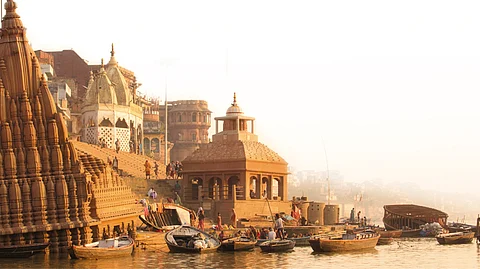

Last year, a fairly routine affair, relocating my trusty Maruti Swift from Kolkata to Delhi, turned into an adventure when I decided to drive down instead of handing over my previous car to a moving company. Of course, some concerns from family and friends had to be brushed aside first. (You're travelling alone! Shall I lend you my driver? Is it safe?). It was only once I was on the road, alone with my thoughts, that it struck me how inextricably intertwined this route was with my life. My folks are from Kanpur. I grew up in Durgapur, a sleepy steel town in West Bengal. I used to live in Kolkata and visit frequently. And I now live in Delhi. Did you guess the connection?
Well, all of these places are on the Grand Trunk Road.

It was a beautiful drive, its scenic splendour enhanced by a post-monsoon patina of green. Each state crossing brought dramatic changes in topography. The flowering of the kans grass, which happens across India but has not been romanticised with as much fervour as in Bengal, had transformed the countryside there. I hate playing favourites but this is the honest truth with lush surroundings and mist-laden hills, Jharkhand was the nicest stretch of the drive. There are many great river crossings on this drive, but none was equal to the 3km crossing over the Sone river in Bihars Rohtas district over a bridge that has been standing since the 1960s (the railway bridge next to it is even older it was built in 1900). By the time Uttar Pradesh came along, the hills had levelled out and the broad Gangetic plain was essentially featureless. The drama here was of a different kind distinctly spiritual in Varanasi, pure heritage in Agra.

The best part is, depending on what you're interested in, you can set the pace and completely customise your itinerary. I was on a mission, so to speak, and zipped through in two days and one night (with an overnight in Varanasi, roughly the midway point), although, in retrospect, this is a course of action I am not recommending. You'd be doing grave injustice to what was once the only grand road on the Indian subcontinent (and it's still the grandest if you ask me). If you go at a leisurely pace, exploring the surrounding countryside, the trip can be easily stretched to two weeks. But a week is perhaps optimal with possible stops in Bodhgaya, Varanasi and Agra (and maybe Allahabad).

THE ROUTE
There is a reason there is a grand in Grand Trunk Road. Now running from Kolkata to Amritsar, at some point, the GT Road stretched from Chittagong in Bangladesh to Kabul in Afghanistan. It is based on an ancient route over two millennia old, which is known to have existed during the reign of Chandragupta Maurya. Then it ran from Pataliputra (present-day Patna) to Takshashila (Taxila, now in Pakistan) at the northwestern frontier of the Mauryan empire. The road as we know it today was rebuilt and extended by Sher Shah Suri in the 16th century. Trees were planted on the roadside to provide shade to travellers and caravanserais were established along the route. Kos minars, ancient milestones, can still be seen at a few places on the road.
Of course, it's a lot of bypasses now, so you may not always be treading that exact historic road, but, for all practical purposes, this is the GT Road now. The 1,500km journey from Kolkata to Delhi follows this route Kolkata-Durgapur-Dhanbad-Aurangabad-Sasaram-Varanasi-Allahabad-Kanpur-Tundla(Agra)-New Delhi. You'll know it as NH19 (previously NH2), but it's also part of the 20,000 km - long Asian Highway 1 (AH1), which runs from Japan to Turkey. By and large, the roads are great, and already six-lane in several parts. You may encounter a few diversions where flyover construction is underway (which is a good thing). Heavy truck traffic, coupled with the rainy season, can wreak havoc on the stretch between Dehri-on-Sone and Sasaram, so watch out for that.

After Agra you are, of course, on the best stretch of road in the country, the Taj Expressway, and it should get you to your destination in a jiffy. If you were to drive nonstop, and I actually know someone who has, it will take you 25 hours. But unless you're trying to set a personal driving record, why bother? It's a simple tradeoff the more bypasses you take, the shorter will be the journey, but also less atmospheric. And vice versa. So research the route and its highlights before you leave, and strike your own personal balance.

Kolkata: As you cross the Nivedita Setu (the famed Kali temple at Dakshineswar to your right) and leave Kolkata behind, a series of colonial enclaves springs up to your side Danish, French, Dutch. Too early to stop, perhaps.
Bodhgaya: This holiest of holy Buddhist pilgrimage sites lies just off the route and is definitely worth considering for an overnight stop.
Sasaram: How can you travel this ancient road without paying homage to the man who built it Sher Shah Suri's mausoleum at Sasaram is a beautiful monument and sits in the middle of an artificial lake.
Varanasi: This ancient town is known for its ghats, temples, cuisine and textiles. Ramnagar Fort is well worth the boat ride to the other bank.
Allahabad: Set at the confluence of the Ganga and Yamuna rivers and site of the Kumbh Mela, this town of sleepy colonial bungalows also has these worthy sights to offer the fort, the museum, Khusro Bagh and Anand Bhavan, the Nehru family home.
Agra: A peerless in its heritage offerings. Besides the Taj Mahal, there is the Agra Fort (and you cannot have a finer view of the Taj from anywhere else) as well as the tomb of Itimad-ud-Daulah. You'll want to pick up a box or two of Panchi petha here. We've heard murmurs of a petha pizza too but fervently hope they're just that murmurs.
